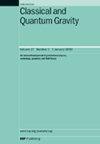Theoretical analysis and simulation verification for measuring the geometric distances between the silicon spheres with the laser interferometer in G measurement
IF 3.7
3区 物理与天体物理
Q2 ASTRONOMY & ASTROPHYSICS
引用次数: 0
Abstract
The Newtonian gravitational constant G is one of the most fundamental constants in nature. In G measurement with the angular acceleration feedback method, the largest error comes from the distances between the geometric centers of the source masses. In the on-going experiment, the silicon spheres with a more homogeneous density are used as the source masses. Here a scheme of measuring the geometric distances between the silicon spheres with the laser interferometer is proposed. The measurement principle is analyzed, and the error sources, such as the laser, the sphere, the alignment of optical path, and the environment are evaluated. With this method, the horizontal and vertical geometric distances can be measured with uncertainties of 11 nm and 9 nm, respectively. The simulation is performed to verify the theoretical model of measuring the distance, where the maximum deviation between the simulation result and the theoretical one is only −2.7 nm. When the sphericities of the four silicon spheres are at the level of 0.1 µm, the uncertainty of each distance after considering the sphericity is about 0.1 µm, corresponds to a combined uncertainty of 0.6 ppm for G measurement with the angular acceleration feedback method. This provides an effective method to reduce the measurement uncertainty of geometric distance between the silicon spheres, and makes it possible to measure G with a higher precision.用激光干涉仪测量G测量中硅球间几何距离的理论分析与仿真验证
牛顿引力常数G是自然界中最基本的常数之一。在角加速度反馈法测量G时,最大误差来自于源质量几何中心之间的距离。在正在进行的实验中,采用密度更均匀的硅球作为源质量。本文提出了一种用激光干涉仪测量硅球间几何距离的方案。分析了测量原理,对激光、球面、光路对准和环境等误差源进行了评价。利用该方法可以测量水平和垂直几何距离,不确定度分别为11 nm和9 nm。通过仿真验证了测量距离的理论模型,仿真结果与理论结果的最大偏差仅为−2.7 nm。当4个硅球的球度为0.1µm时,考虑球度后各距离的不确定度约为0.1µm,对应于角加速度反馈法测量G的不确定度为0.6 ppm。这为减小硅球之间几何距离的测量不确定度提供了一种有效的方法,使测量G的精度更高。
本文章由计算机程序翻译,如有差异,请以英文原文为准。
求助全文
约1分钟内获得全文
求助全文
来源期刊

Classical and Quantum Gravity
物理-天文与天体物理
CiteScore
7.00
自引率
8.60%
发文量
301
审稿时长
2-4 weeks
期刊介绍:
Classical and Quantum Gravity is an established journal for physicists, mathematicians and cosmologists in the fields of gravitation and the theory of spacetime. The journal is now the acknowledged world leader in classical relativity and all areas of quantum gravity.
 求助内容:
求助内容: 应助结果提醒方式:
应助结果提醒方式:


